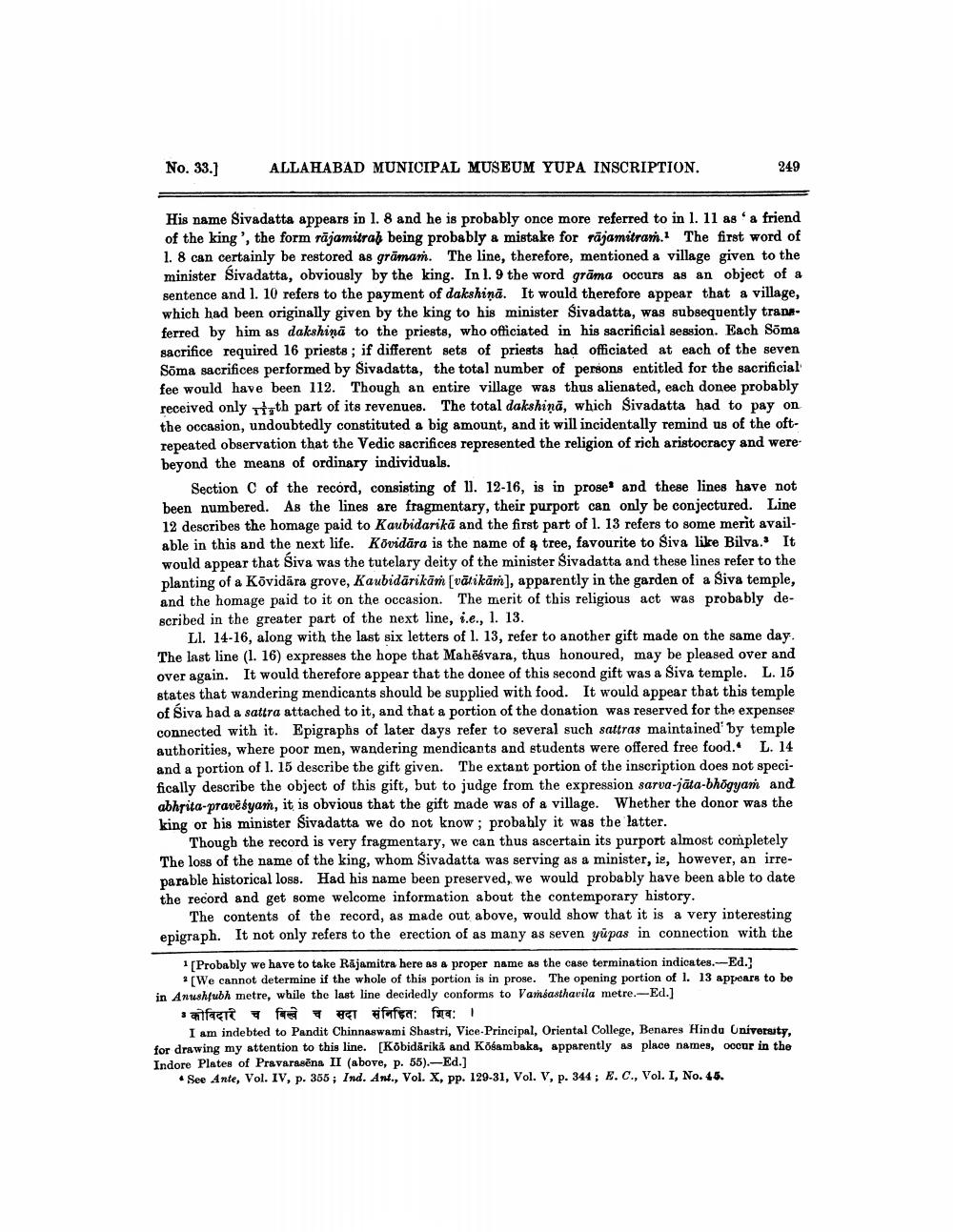________________
No. 33.]
ALLAHABAD MUNICIPAL MUSEUM YUPA INSCRIPTION.
249
His name Sivadatta appears in l. 8 and he is probably once more referred to in l. 11 as a friend of the king', the form räjamitrab being probably a mistake for rājamitran. The first word of 1. 8 can certainly be restored as grāmam. The line, therefore, mentioned a village given to the minister Sivadatta, obviously by the king. In l. 9 the word grāma occurs as an object of a sentence and 1. 10 refers to the payment of dakshiņā. It would therefore appear that a village, which had been originally given by the king to his minister Sivadatta, was subsequently transferred by him as dakshina to the priests, who officiated in his sacrificial session. Each Sõma sacrifice required 16 priests; if different sets of priests had officiated at each of the seven Söma sacrifices performed by Sivadatta, the total number of persons entitled for the sacrificial fee would have been 112. Though an entire village was thus alienated, each donee probably received only tişth part of its revenues. The total dakshinā, which Sivadatta had to pay on the occasion, undoubtedly constituted a big amount, and it will incidentally remind us of the oftrepeated observation that the Vedic sacrifices represented the religion of rich aristocracy and were beyond the means of ordinary individuals.
Section of the record, consisting of 11. 12-16, is in prose and these lines have not been numbered. As the lines are fragmentary, their purport can only be conjectured. Line 12 describes the homage paid to Kaubidarikā and the first part of l. 13 refers to some merit available in this and the next life. Kövidāra is the name of tree, favourite to Siva like Bilva.' It would appear that Siva was the tutelary deity of the minister Sivadatta and these lines refer to the planting of a Kövidāra grove, Kaubidārikām (vātikām), apparently in the garden of a Siva temple, and the homage paid to it on the occasion. The merit of this religious act was probably described in the greater part of the next line, i.e., 1. 13.
Ll. 14-16, along with the last six letters of l. 13, refer to another gift made on the same day. The last line (1. 16) expresses the hope that Mahēšvara, thus honoured, may be pleased over and over again. It would therefore appear that the donee of this second gift was a Siva temple. L. 15 states that wandering mendicants should be supplied with food. It would appear that this temple of Siva had a sattra attached to it, and that a portion of the donation was reserved for the expenses connected with it. Epigraphs of later days refer to several such sattras maintained by temple authorities, where poor men, wandering mendicants and students were offered free food. L. 14 and a portion of l. 15 describe the gift given. The extant portion of the inscription does not specifically describe the object of this gift, but to judge from the expression sarva-jāta-bhögyam and abhrita-pravēsyan, it is obvious that the gift made was of a village. Whether the donor was the king or his minister Sivadatta we do not know; probably it was the latter.
Though the record is very fragmentary, we can thus ascertain its purport almost completely The loss of the name of the king, whom Sivadatta was serving as a minister, ie, however, an irreparable historical loss. Had his name been preserved, we would probably have been able to date the record and get some welcome information about the contemporary history.
The contents of the record, as made out above, would show that it is a very interesting epigraph. It not only refers to the erection of as many as seven yüpas in connection with the
1 [Probably we have to take Rajamitra here as a proper name as the case termination indicates.-Ed.)
*(We cannot determine if the whole of this portion is in prose. The opening portion of l. 13 appears to be in Anushfubh metre, while the last line decidedly conforms to Vamsasthavila metre.-Ed.]
safari fra Tefafsa: fra:
I am indebted to Pandit Chinnaswami Shastri, Vice-Principal, Oriental College, Benares Hinda University, for drawing my attention to this line. [Köbidárika and Kósambaka, apparently as place names, occur in the Indore Plates of Pravarasēns II (above, p. 55).-Ed.]
• See Ante, Vol. IV, p. 365; Ind. An., Vol. X, pp. 129-31, Vol. V, p. 344; E. C., Vol. I, No. 45.




